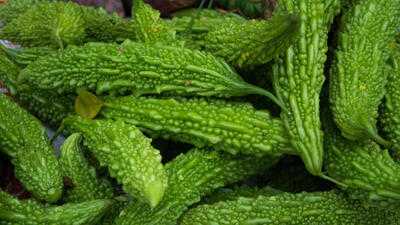Diabetes management doesn’t always require expensive supplements or drastic lifestyle changes. According to certified Gurugram-based nutritionist and weight loss specialist Leema Mahajan, some everyday Indian vegetables contain compounds that naturally support blood sugar control. Sharing her tips on Instagram, Mahajan highlighted nine nutrient-rich vegetables that act as natural insulin boosters, making them an easy addition to Indian kitchens.
Ridge Gourd (Turai / Tori)
Ridge gourd contains apigenin and luteolin, compounds known to boost insulin secretion and improve glucose uptake. Including this vegetable in regular meals can support your body’s natural blood sugar regulation.

Pointed Gourd (Parwal)
Packed with trichosanthin, cucurbitacin, and lupeol, pointed gourd helps improve insulin sensitivity and reduces post-meal sugar spikes, making it a smart choice for diabetic diets.

Ivy Gourd (Kundru / Tindora)
Ivy gourd contains cucurbitacin B and terpenoids, which mimic insulin action, aiding in lowering blood sugar levels naturally.
Cluster Beans (Gawar Phali)
High in guar gum, a soluble fiber, cluster beans slow carbohydrate absorption and help control post-meal glucose surges.
Snake Gourd (Chichinda / Padval)
With antioxidants like saponins and flavonoids, snake gourd reduces oxidative stress and improves glucose tolerance.

Drumsticks (Sahjan ki Phali)
Drumsticks are rich in chlorogenic acid, which helps curb post-meal sugar spikes and supports overall glycemic control.
Bitter Gourd (Karela)
Known for its potent antidiabetic properties, bitter gourd contains charantin and polypeptide-p, compounds that act like natural insulin to lower blood glucose.

Raw Papaya (Kacha Papita)
Flavonoids and papain in raw papaya aid glucose metabolism and protect pancreatic cells, making it a valuable vegetable for diabetes management.

Kantola (Spiny Gourd / Kakrol)
Kantola contains phenolic compounds that enhance insulin sensitivity and exhibit hypoglycemic effects, supporting natural blood sugar regulation.
Why These Vegetables Matter
Nutritionist Leema Mahajan emphasizes that these vegetables are light, nutrient-rich, and practical for everyday Indian cooking. “These common veggies have powerful compounds that support blood sugar control without any fad diets or shortcuts,” she says.
Her approach focuses on science-backed, sustainable nutrition tailored for real lives. By incorporating these vegetables into regular meals, individuals can complement medication, support insulin function, and maintain healthier glucose levels naturally.
From ridge gourd to spiny gourd, Indian kitchens are stocked with vegetables that can do more than fill your plate—they can help regulate blood sugar naturally. Adding them to daily meals, alongside lifestyle adjustments like exercise and hydration, offers a simple, effective strategy for long-term diabetes management.
Ridge Gourd (Turai / Tori)
Ridge gourd contains apigenin and luteolin, compounds known to boost insulin secretion and improve glucose uptake. Including this vegetable in regular meals can support your body’s natural blood sugar regulation.

Pointed Gourd (Parwal)
Packed with trichosanthin, cucurbitacin, and lupeol, pointed gourd helps improve insulin sensitivity and reduces post-meal sugar spikes, making it a smart choice for diabetic diets.

Ivy Gourd (Kundru / Tindora)
Ivy gourd contains cucurbitacin B and terpenoids, which mimic insulin action, aiding in lowering blood sugar levels naturally.
Cluster Beans (Gawar Phali)
High in guar gum, a soluble fiber, cluster beans slow carbohydrate absorption and help control post-meal glucose surges.
Snake Gourd (Chichinda / Padval)
With antioxidants like saponins and flavonoids, snake gourd reduces oxidative stress and improves glucose tolerance.

Drumsticks (Sahjan ki Phali)
Drumsticks are rich in chlorogenic acid, which helps curb post-meal sugar spikes and supports overall glycemic control.
Bitter Gourd (Karela)
Known for its potent antidiabetic properties, bitter gourd contains charantin and polypeptide-p, compounds that act like natural insulin to lower blood glucose.
Raw Papaya (Kacha Papita)
Flavonoids and papain in raw papaya aid glucose metabolism and protect pancreatic cells, making it a valuable vegetable for diabetes management.

Kantola (Spiny Gourd / Kakrol)
Kantola contains phenolic compounds that enhance insulin sensitivity and exhibit hypoglycemic effects, supporting natural blood sugar regulation.
Why These Vegetables Matter
Nutritionist Leema Mahajan emphasizes that these vegetables are light, nutrient-rich, and practical for everyday Indian cooking. “These common veggies have powerful compounds that support blood sugar control without any fad diets or shortcuts,” she says.
Her approach focuses on science-backed, sustainable nutrition tailored for real lives. By incorporating these vegetables into regular meals, individuals can complement medication, support insulin function, and maintain healthier glucose levels naturally.
From ridge gourd to spiny gourd, Indian kitchens are stocked with vegetables that can do more than fill your plate—they can help regulate blood sugar naturally. Adding them to daily meals, alongside lifestyle adjustments like exercise and hydration, offers a simple, effective strategy for long-term diabetes management.
You may also like

Cong alleges 'unholy alliance' between Kerala CM Vijayan and BJP

Arsenal dressing room's true feelings on 'problem' behind Premier League title misses

Nagaland State Lottery Result: Oct 11, 2025, 1 PM Live - Watch Streaming Of Winners List Of Dear Narmada Sambad Morning Saturday Weekly Draw

India Women vs Australia Women Prediction Match 13, ICC Womens World Cup 2025 - Who will win today IN-W vs AU-W match?

Watch: SRK spotted dancing at 3 am to his 90s hit songs






